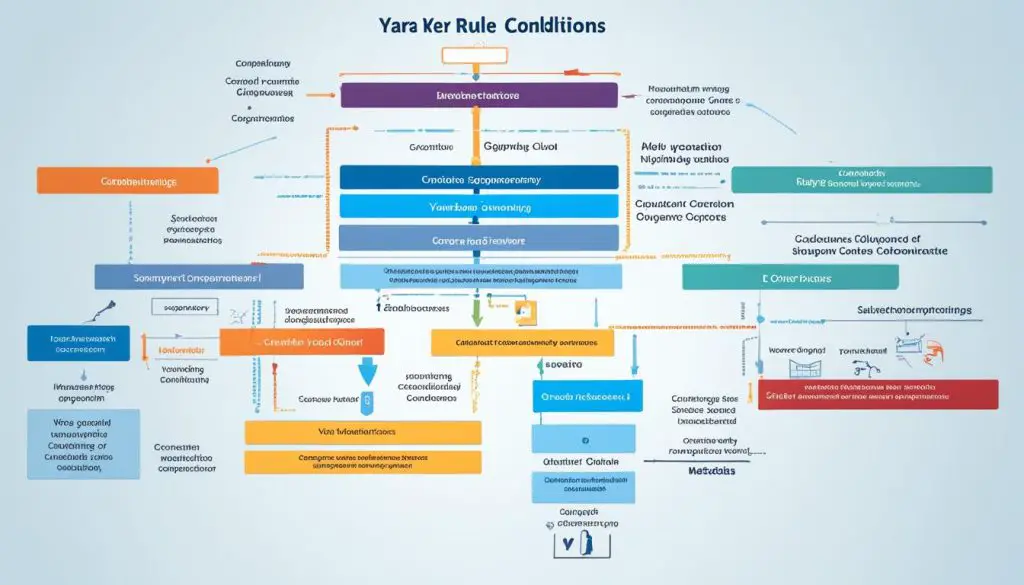What are Yara Rules in Cybersecurity
When it comes to combating malware and ensuring cybersecurity, professionals need all the help they can get. That’s where Yara rules come into play. But what exactly are Yara rules, and how do they work? In this article, I will explain the ins and outs of Yara rules, their importance in cybersecurity, and how they can make a difference in detecting and analyzing malware.
Imagine being able to classify and identify malware samples based on specific patterns or characteristics. With Yara rules, this becomes a reality. But there’s more to it than that. Yara rules offer flexibility, precision, and adaptability, allowing cybersecurity professionals to stay one step ahead of potential threats. So, let’s dive in and uncover the world of Yara rules in cybersecurity.
Key Takeaways
- Yara rules are a crucial tool for detecting and analyzing malware.
- They allow cybersecurity professionals to classify and identify malware based on specific patterns.
- Yara rules consist of import, metadata, strings, condition, and rule name elements.
- Importing modules in Yara rules enhances their capabilities.
- Metadata provides additional information about the rule for organizational purposes.
Understanding Yara Rules
Yara rules are an essential aspect of the Yara framework, which is specifically designed for large-scale pattern matching in the field of cybersecurity. These rules serve the purpose of describing and classifying various malware families based on their distinct patterns and characteristics. However, Yara rules are not limited to malware detection alone; they can also identify other digital artifacts within files or binary datasets. This versatility makes Yara rules an invaluable tool in the ongoing battle against cyber threats.
The syntax of Yara rules revolves around the utilization of sets of strings, regular expressions, and condition logic. These features enable cybersecurity professionals to precisely and effectively detect the presence of malware samples or digital anomalies. By leveraging these syntactical elements, analysts can create powerful and adaptive Yara rules, allowing them to stay one step ahead of potential threats.
Yara Rules Syntax
The syntax of Yara rules relies heavily on the utilization of strings, regular expressions, and condition logic. Strings can encompass different types of data, including text strings, hexadecimal byte sequences, or even regular expressions. Regular expressions provide a flexible pattern-matching mechanism for the detection of specific text patterns or structures within files or datasets. This diverse range of syntactical components equips cybersecurity professionals with a powerful and adaptable arsenal for detecting and analyzing malware samples.
Yara Rules Examples
“rule Detect_Malware {
strings:
$magic = { 4D 5A }
condition:
$magic at 0
}”
The above example illustrates a simple Yara rule used for detecting malware. The rule consists of a condition section that checks if the hexadecimal byte sequence “4D 5A” (commonly known as the ‘MZ’ executable header) exists at the start of a file. If the condition is met, the rule will trigger, indicating the presence of potentially malicious software.
Yara Rules Tutorial
Learning how to create effective Yara rules requires a comprehensive understanding of the syntax and components involved. Online tutorials and guides provide valuable resources for individuals looking to dive deeper into Yara rule development. These tutorials typically cover topics such as rule structure, string matching techniques, regular expression usage, and advanced rule crafting. By following these tutorials, cybersecurity professionals can enhance their knowledge and skills in utilizing Yara rules effectively.
The Five Main Elements of Yara Rules
Yara rules are comprised of five essential elements that contribute to their structure and effectiveness in cybersecurity. These elements include import, metadata, strings, condition, and rule name.
Import
The import element in Yara rules allows for the utilization of external modules, which enhance the capabilities of the rule. By importing these modules, cybersecurity professionals can expand the functionality of their rules and increase the scope of detection.
Metadata
The metadata element provides additional information about the rule. It includes details such as the author, source, and description. This information helps cybersecurity professionals organize and understand the purpose and context of the rule.
Strings
The strings element in Yara rules defines the patterns or signatures that are searched for in the analyzed samples. These patterns can be text strings, hexadecimal byte sequences, or regular expressions. By specifying strings, analysts can pinpoint specific characteristics or behaviors indicative of malware.
Condition
The condition element in Yara rules specifies the logic that needs to be satisfied for the rule to match. This logic can involve pattern matching, file size checks, or other conditions based on the characteristics of the analyzed samples. Conditions play a crucial role in determining the relevance of the rule to the specific threat being detected.
Rule Name
The rule name element in Yara rules denotes the unique name of the rule. It serves as an identifier, helping to organize and categorize rules within a collection or database. A well-defined rule name enhances the readability and usability of the Yara rule.
Understanding and implementing these five main elements of Yara rules is essential for effective threat detection and response. By utilizing import statements, providing relevant metadata, defining strings, setting logical conditions, and assigning unique rule names, cybersecurity professionals can enhance their Yara rules’ effectiveness in identifying and combating malware threats.
Importing Modules in Yara Rules
The import section of a Yara rule is a powerful feature that allows me to enhance the capabilities of my rules by utilizing external modules. These modules provide additional functions and methods that enable me to access and evaluate data types or structures not natively supported by Yara’s standard rule language.
One example of an external module that I frequently use is the PE module, which enables me to analyze Portable Executable files commonly found in Windows environments. By importing this module, I can craft rules that specifically search for certain characteristics within PE file headers or sections.
These external modules expand the range of possibilities when it comes to creating Yara rules. They allow me to dig deeper into the analysis of different file formats, opening up more opportunities for effective malware detection and threat hunting.
“By importing external modules, I can unleash the full potential of my Yara rules, unlocking the ability to target specific features and behaviors within different file types and structures. The flexibility and adaptability provided by these modules are invaluable in the ever-evolving landscape of cybersecurity.”
With the ability to import external modules, my Yara rules become even more powerful and versatile. I can enhance the accuracy and effectiveness of my detections, ensuring that even the most sophisticated malware can be identified and analyzed.
Metadata in Yara Rules
Yara rules can contain a metadata section that provides valuable additional information about the rule. This metadata includes details such as the author, source, description, and date of creation. By including metadata in Yara rules, we can provide essential context and organization, making it easier for others to understand and effectively utilize the rule.
This metadata section serves as a reference point, allowing cybersecurity professionals to quickly identify the rule’s purpose, authorship, and relevant details. For example, the author field helps attribute credit or responsibility for the rule’s creation, enabling collaboration and acknowledgment among peers in the cybersecurity community.
Furthermore, the description field within the metadata allows for a concise explanation of the rule’s intent, aiding in the comprehension of its functionality. Effective descriptions help users recognize the specific characteristics or behaviors the rule is designed to detect, enhancing its usefulness in real-world cybersecurity scenarios.
The metadata section is not only beneficial for the creators of the Yara rules, but it also facilitates collaboration, knowledge sharing, and overall rule management within a larger cybersecurity framework. The ease of reference and organization provided by metadata ultimately contributes to more efficient and effective threat detection and response strategies.
When creating Yara rules, incorporating comprehensive metadata can significantly enhance their usefulness and overall impact on security measures. By including important details such as the rule author, source, description, and creation date, cybersecurity professionals can streamline rule management and foster a stronger collaborative environment.
Strings in Yara Rules
When it comes to Yara rules, strings are the building blocks of effective malware detection and threat hunting. These strings define the patterns or signatures to be searched for in the analyzed samples, enabling cybersecurity professionals to find specific characteristics within files.
The beauty of Yara rules is that they allow for flexibility in defining strings. Whether it’s text strings, hexadecimal byte sequences, or regular expressions, Yara rules can handle them all. This versatility enables analysts to extract and examine embedded strings, gaining valuable insights into the capabilities and behaviors of malware samples.
For example, by utilizing Yara rule string extraction techniques, analysts can uncover hidden command and control (C2) domains or unique strings associated with known malware families. This knowledge is crucial for identifying and responding to potential threats swiftly and effectively.
With Yara rule string patterns, cybersecurity professionals have a powerful tool at their disposal. These patterns enable precise matching of specific characteristics within analyzed samples, improving the accuracy of malware detection. Whether it’s a specific string found in ransomware, a unique encryption key, or a characteristic behavior pattern, Yara rules can help spot them all.
Furthermore, Yara rule string patterns can be combined with other conditions and custom logic to create sophisticated detection rules. By leveraging the rich syntax of Yara rules, analysts can create rules that factor in multiple string patterns, file sizes, or other conditions to accurately identify and classify malware.
Yara rules’ utilization of strings facilitates not only in malware detection but also in the broader field of threat hunting. By crafting rules that match specific string patterns found in known indicators of compromise (IoCs), analysts can proactively hunt for threats within their organization’s networks and systems.
Yara rule strings are like breadcrumbs that lead cybersecurity professionals to malware and threats hiding within files and binary datasets.
With Yara rule string patterns, cybersecurity professionals can enhance their incident response capabilities and stay one step ahead of emerging threats. By continuously refining and updating Yara rules with new string patterns, analysts can adapt to the ever-evolving threat landscape.
Key Takeaways:
- Strings are integral to Yara rules, defining the patterns or signatures to search for in analyzed samples.
- Yara rules handle various types of strings, including text strings, hexadecimal byte sequences, and regular expressions.
- By extracting and examining embedded strings, cybersecurity professionals gain insights into malware behavior.
- Yara rules utilize string patterns for precise matching of specific malware characteristics.
- Combining Yara rule strings with other conditions and logic enhances detection accuracy and threat hunting capabilities.
Conditions in Yara Rules
The condition section of a Yara rule plays a crucial role in determining the logic that must be satisfied for the rule to match. By defining specific conditions based on the characteristics of the analyzed samples, Yara rules enable effective malware identification and classification.
The conditions in Yara rules encompass various aspects, including pattern matching, file size checks, and other logical criteria. These conditions are essential for accurately detecting and categorizing malware based on the defined patterns and behaviors.
Pattern matching is a fundamental aspect of Yara rules. By specifying patterns to search for within the analyzed samples, cybersecurity professionals can identify unique characteristics associated with specific malware families or behaviors. The flexibility of Yara rule conditions allows for precise and adaptable pattern matching, enhancing the accuracy of malware detection.
Yara rule conditions enable cybersecurity professionals to define the logic required for pattern matching, file size checks, and other criteria necessary for accurate malware identification and classification.
In addition to pattern matching, Yara rule conditions can also incorporate file size checks. This ensures that the rule only matches samples that meet specific size thresholds, allowing for more targeted analysis. By imposing file size conditions, cybersecurity professionals can filter out irrelevant or non-malicious files, optimizing the efficiency of their detection processes.
Yara rule conditions are based on conditional logic, which enables the rule to evaluate multiple criteria simultaneously. This logic allows for complex pattern matching and decision-making processes, enhancing the rule’s ability to accurately identify and classify malware samples. By utilizing logical operators such as AND, OR, and NOT, cybersecurity professionals can create sophisticated conditions that reflect the intricacies of malware behavior.
Enhancing Pattern Matching with Yara Rule Conditions
Yara rule conditions complement the pattern matching capabilities of Yara rules, enabling a comprehensive approach to malware detection and classification. By combining logical conditions with pattern matching, cybersecurity professionals can create robust rules that maximize the accuracy and efficiency of their analysis.
The flexibility and adaptability of Yara rule conditions make them a powerful tool for cyber defense. Whether detecting known malware families or identifying emerging threats, Yara rules with well-defined conditions provide a proactive defense against cyber attacks.
By leveraging Yara rule conditions, cybersecurity professionals can strengthen their defenses by accurately matching specific patterns, evaluating file sizes, and applying logical reasoning to identify and classify malware. This comprehensive approach empowers organizations to stay one step ahead in the ever-evolving landscape of cybersecurity.

- Yara rule conditions enable precise pattern matching and logic-based decision-making in malware detection.
- Conditions can incorporate file size checks to filter out irrelevant samples and optimize analysis.
- The logical operators used in Yara rule conditions enhance the complexity and accuracy of pattern matching.
- Combining pattern matching with conditions creates robust rules for proactive cyber defense.
- Yara rule conditions provide cybersecurity professionals with a comprehensive approach to identifying and classifying malware.
Rule Name in Yara Rules
In Yara rules, the rule name element serves as an essential component that uniquely identifies each rule. It plays a crucial role in organizing and categorizing rules within a collection or database. A well-defined rule name enhances the readability and usability of the Yara rule, making it easier for cybersecurity professionals to identify and utilize specific rules.
When naming Yara rules, it is important to follow a consistent naming convention that reflects the purpose or functionality of the rule. A clear and descriptive rule name aids in quickly understanding the rule’s intent and ensures that rules can be easily distinguished from one another within a collection.
The rule name also facilitates Yara rule identification, especially when working with large sets of rules. By using informative and concise names, analysts can quickly pinpoint the specific rules they need and locate relevant information related to those rules.
Having well-defined rule names in Yara rules is crucial for efficient rule management and effective threat detection. A descriptive and informative rule name brings clarity to the purpose and functionality of the rule, making it easier for analysts to identify, categorize, and utilize the rules when analyzing potential threats.
The Structure of Yara Rules
Yara rules are composed of three main sections: the rule header, the condition, and the body. Each section plays a vital role in creating effective and precise detection rules.
1.
Rule Header
The rule header is where the name and metadata of the rule are defined. It provides essential information about the purpose and origin of the rule. By naming your rule appropriately and providing descriptive metadata, you can improve the organization and understanding of your rule collection.
2.
Condition
The condition section contains the logic that needs to be satisfied for the rule to match. It combines strings, variables, and operators to define specific patterns or characteristics to be detected within the analyzed samples. By crafting accurate and robust conditions, you can enhance the accuracy of your malware detection.
3.
Body
The body section specifies the actions to be taken when a match is found. This can include displaying a message, executing a script, or any other custom action. The body section allows for flexibility and customization in how you respond to detected malware, suiting your specific cybersecurity needs.
The structure of Yara rules, with its distinct sections, allows for precise and effective detection of malware. The rule header provides necessary information, the condition defines the matching logic, and the body dictates the actions to be taken.
The image above visually represents the structure of Yara rules, reinforcing the importance of each section in the rule creation process.
Conclusion
Yara rules are of utmost importance in bolstering cybersecurity measures. As a powerful tool for detecting and analyzing malware, they provide precision and adaptability in identifying specific patterns and characteristics within files and binary datasets. By understanding and utilizing the elements, syntax, and structure of Yara rules, cybersecurity professionals can enhance their ability to detect and respond to potential threats.
The significance of Yara rules in cybersecurity cannot be overstated. Their ability to classify and identify malware samples based on textual or binary patterns allows for efficient threat detection and analysis. With Yara rules, cybersecurity professionals can stay one step ahead of cybercriminals, safeguarding critical systems and data.
In an ever-evolving threat landscape, the detection of malicious activities is paramount. Yara rules play a crucial role in this process, equipping cybersecurity experts with the means to effectively detect and combat emerging threats. Their adaptable nature allows for the creation of rules specific to the organization’s needs, enabling proactive measures against potential vulnerabilities.
In conclusion, Yara rules are an indispensable asset in the fight against cybersecurity threats. Their importance lies in their ability to detect and analyze malware, fortifying the defenses of organizations. By harnessing the power of Yara rules, cybersecurity professionals can enhance their detection capabilities and better protect the digital landscape.
FAQ
What are Yara rules in cybersecurity?
How can I understand Yara rules?
What are the five main elements of Yara rules?
How can I import modules in Yara rules?
What is the role of metadata in Yara rules?
How do strings function in Yara rules?
What is the significance of conditions in Yara rules?
What does the rule name element signify in Yara rules?
What is the structure of Yara rules?
How do Yara rules contribute to cybersecurity?
- About the Author
- Latest Posts
Claudia Rothenhorst ist Medien- und Reise-Redakteurin bei der Web-Redaktion. In ihrer Freizeit reist sie gerne und schreibt darüber unter anderem auf Reisemagazin.biz.
Weitere Artikel von Ihr erscheinen u.a. im Blog der Webagentur Awantego.





